Key Takeaways:
The global video streaming market is set to hit $416.84B by 2030 with a 21.5% CAGR, driven by mobile growth, fast internet, and on-demand entertainment, making this the ideal time to launch a streaming app.
Know your types: VOD, live streaming, OTT TV, eLearning, fitness, to align features, monetization, and tech with audience needs.
Essential features of a video streaming app include adaptive streaming, profiles, multi-device support, DRM, watchlists, plus compliance with copyright, privacy, and accessibility.
Creating a video streaming app starts from niche selection, user-focused design, scalable tech, multi-device testing for top performance and retention.
Monetize via SVOD, AVOD, TVOD, hybrids, and in-app purchases to reach varied audiences and drive growth.
From ambitious startups to industry veterans, the rise of streaming platforms has unlocked a goldmine of business opportunities.
In today’s digital era, creating engaging, high-quality content is only half the game; the real win is how you deliver it.
If you’re looking for a guide to develop a video streaming app, here’s the truth: the market has never been hotter.
According to Statista, the global video streaming market is projected to hit $416.84 billion by 2030, growing at a remarkable 21.5% CAGR between 2023 and 2030.
This surge is powered by skyrocketing mobile usage, faster internet speeds, and an ever-growing appetite for on-demand entertainment.
Now is the perfect moment to create a video streaming app that can stand shoulder-to-shoulder with Netflix or Disney+ or even carve out your own niche streaming empire.
In this blog, we’ll walk you through how to develop a video streaming app from the initial concept and crafting the perfect UI/UX to launching, scaling, and monetizing your platform.
What is a Video Streaming App?
A video streaming app is a digital platform that allows users to watch videos online without downloading them.
Instead of storing files locally, the content is delivered in real time over the internet, giving users instant access to movies, shows, live events, or user-generated videos.
Popular platforms like Netflix, YouTube, Hotstar, and Amazon Prime Video are classic examples of video streaming apps. These apps use cloud-based servers and powerful video players to deliver seamless playback across devices.
With the rise of smartphones and high-speed internet, streaming apps have become the go-to medium for content consumption, fueling the rise of OTT app development across industries.
With the boom in smartphones and high-speed internet, streaming apps have overtaken traditional media, driving an unprecedented wave of OTT app development across industries. Today, whether it’s binge-watching a drama series, catching a live concert, or streaming a gaming session, users expect flawless quality and instant access.
Broadly, video streaming apps fall into two categories:
-
On-Demand Streaming: like Netflix or Prime Video, where users can watch content anytime.
-
Live Streaming: like Twitch or Facebook Live, where events happen in real time.
Let’s get to know them in detail:
What Are Different Types of Video Streaming Apps
Before you make a video streaming app, it’s important to understand the different types of platforms dominating the market.
Each type serves a unique purpose and caters to different user preferences and content strategies.
Choosing the right model depends on your app idea and target audience.
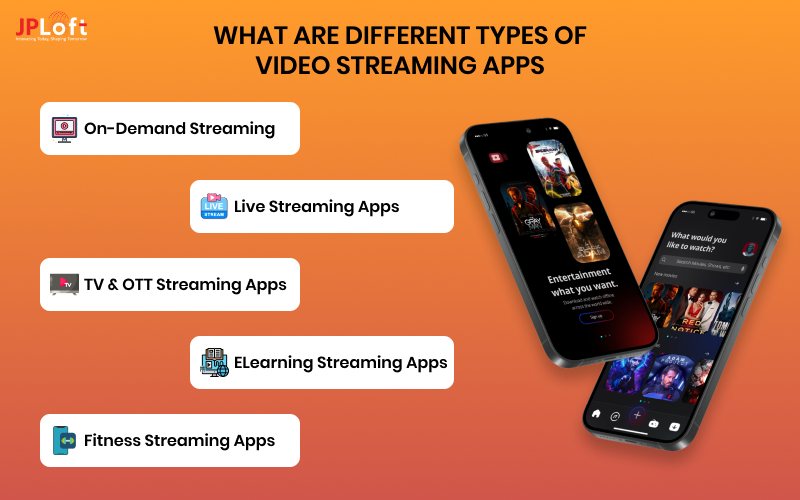
1. On-Demand Video Streaming Apps (VOD)
These platforms let users watch content anytime, anywhere. Popular examples include Netflix, Amazon Prime Video, and Disney+.
If you’re planning to start an online video streaming business, this model offers long-term scalability and monetization options like subscriptions or pay-per-view.
Ideal for businesses that want to build a video streaming app offering movies, web series, tutorials, or educational content.
2. Live Streaming Apps
Live streaming is perfect for broadcasting real-time content, like webinars, events, concerts, or gaming. Think Twitch, Facebook Live, or YouTube Live.
With live streaming app development, you can create engaging, interactive experiences through live chat, reactions, and viewer polls.
Useful for content creators, influencers, and brands looking to build real-time engagement.
3. TV & OTT Streaming Apps
These apps offer access to TV shows and channels over the internet, no cable required. Examples include Hulu, Sling TV, and Hotstar.
If you’re gearing up for OTT app development to serve a wide audience with diverse tastes, the market is wide open.
4. Educational & eLearning Streaming Apps
These apps cater to schools, coaching institutes, or individual educators. They provide pre-recorded courses, live classes, and student interaction tools.
When you build a video streaming app tailored for education, consider features like screen sharing, notes, quizzes, and progress tracking.
Investors who plan such ideas often take steps ahead with an expert education app development company to make sure they deliver a platform that’s engaging, scalable & built for long-term success.
5. Fitness & Wellness Streaming Apps
From yoga classes to gym workouts, fitness video apps have seen massive growth.
Users can join live sessions or follow recorded routines.
Innovative fitness app development services enable integration of wearable tracking, nutrition guidance, and on-demand classes into your streaming app.
Add live trainer support, wearable integration, and session tracking for a standout experience.
No matter which category you choose, understanding the right type of platform helps you align features, monetization, and technology from day one.
With the right strategy and expert team, you can successfully start your app development journey and create a product that stands out in this competitive digital era.
Before you move forward with planning, it’s helpful to see what the leaders in the streaming market are doing.
Studying top platforms will not only inspire feature ideas but also reveal potential gaps you can fill.
Why Should You Develop a Video Streaming App?
With digital consumption at an all-time high, businesses and creators are tapping into the power of video to connect, engage, and monetize.
Whether you're planning to stream movies, host live events, or build a niche content platform, there’s never been a better time to build a video streaming app.
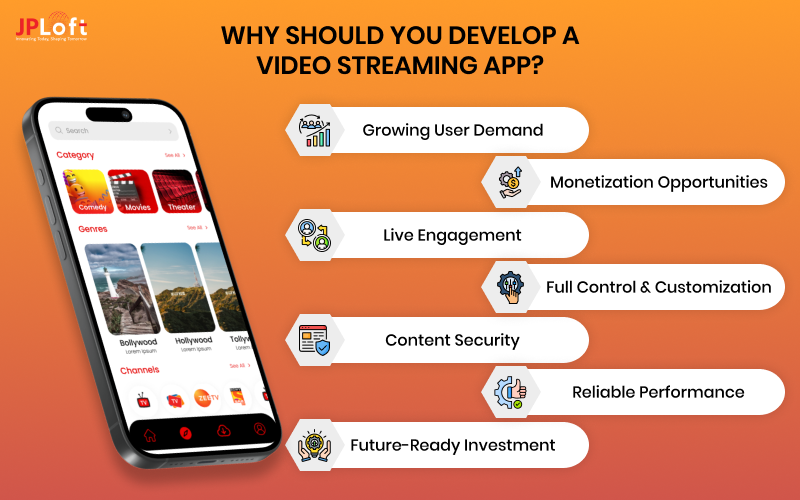
-
Growing User Demand: The global appetite for video content is skyrocketing. Creating your own platform puts you in the race with the other top apps like Netflix, Hulu, or YouTube.
-
Monetization Opportunities: With Video on Demand (VOD) app development, you can offer subscription-based content, pay-per-view, or ad-supported models, tailored to your audience and revenue goals.
-
Live Engagement: Live streaming app development enables real-time interaction with users, perfect for events, webinars, sports, or influencer content.
-
Full Control & Customization: With custom video streaming app development, you can control UI/UX, features, and branding, something you can’t achieve on third-party platforms.
-
Content Security: Implementing DRM for video apps ensures that your premium content is protected from piracy and unauthorized distribution.
-
Reliable Performance: Investing in secure video streaming solutions gives users a seamless, buffer-free experience on any device, anywhere.
-
Future-Ready Investment: With the rise in content creators, e-learning, and OTT platforms, video streaming app development is a smart, scalable digital venture.
Starting now gives you a competitive edge in the ever-expanding video economy. Whether for entertainment, education, or enterprise, building your own streaming platform opens up endless possibilities.
Competitor Analysis of Top Video Streaming Platforms
The global streaming market is filled with heavyweights that have set the gold standard in user experience, content variety, and monetization strategies.
Understanding what makes these platforms successful can guide you if you’re looking to build an app with similar capabilities.
Below is a quick overview of some of the top video streaming apps and what sets them apart.
|
Platform |
Launch Year |
Monetization Model |
Unique Features |
Platforms Available |
|
Netflix |
2007 |
SVOD |
AI-based recommendations, multiple profiles |
iOS, Android, Web, Smart TV |
|
Disney+ |
2019 |
SVOD |
Exclusive Disney, Pixar, Marvel content |
iOS, Android, Web, Smart TV |
|
Hulu |
2007 |
Hybrid (SVOD + AVOD) |
Live TV + On-demand |
iOS, Android, Web, Roku |
|
Twitch |
2011 |
AVOD + Subscriptions |
Live chat, streamer subscriptions |
iOS, Android, Web |
|
Shahid |
2008 |
SVOD |
Arabic content library, regional exclusives |
iOS, Android, Web, Smart TV |
|
YouTube |
2005 |
AVOD + TVOD |
User-generated content, live streaming |
iOS, Android, Web, Smart TV |
► Key Takeaways from Each Platform
Studying these platforms can help you decide whether to follow a similar model or carve out a unique niche.
-
Netflix: If you want to develop an app like Netflix, focus on personalized recommendations and multi-profile support to improve engagement and retention.
-
Disney+: To create an app like Disney+, secure exclusive rights or partnerships for popular content and emphasize brand-driven storytelling.
-
Hulu: You can build an app like Hulu by blending live TV with on-demand shows and offering flexible subscription tiers.
-
Twitch: To develop an app like Twitch, prioritize community engagement with live chat, creator tools, and interactive monetization options.
-
Shahid: You could create an app like Shahid by curating niche or regional content libraries with strong cultural appeal.
-
YouTube: If you aim to build an app like YouTube, allow user-generated content uploads, live streaming, and a mix of ad-based and premium monetization.
From pricing to platform compatibility, these examples highlight the decisions you’ll need to make when you create your own video streaming app.
Core Features of Video streaming app
To build a successful platform, your app must include essential video streaming app features that support seamless viewing, personalization, security, and scalability.
Whether you're focusing on Video on Demand (VOD) app or live streaming app development, here are the must-have features:
|
Feature |
Description |
|
User Registration & Profiles |
Easy login via email/social accounts; supports personalized profiles. |
|
Content Discovery & Search |
Smart search with filters and recommendations for better user experience. |
|
High-Quality Video Playback |
Adaptive streaming to ensure smooth and buffer-free video delivery. |
|
Video Player Controls |
Basic playback controls, subtitles, speed control, and skip options. |
|
Live Streaming Capability |
Key for live streaming app, includes real-time chat and stats. |
|
DRM Integration |
Use DRM for video apps to ensure secure video streaming solutions. |
|
Multi-Platform Compatibility |
Works on iOS, Android, web, and smart TVs to reach wider audiences. |
|
Monetization Options |
Include SVOD, AVOD, TVOD for scalable VOD app development models. |
|
Watchlist & Downloads |
Save shows for later and enable offline viewing like the top video streaming apps. |
|
Analytics Dashboard |
Real-time insights for content performance and user behavior. |
|
Push Notifications |
Alert users about new content, live events, or special offers. |
|
Backend CMS |
Robust system to manage video content and categories in your custom video streaming app. |
These features form the backbone of any modern app aiming for success in the video content space.
By integrating them effectively, you set the foundation for building a feature-rich, secure, and user-centric product.
Key Compliance Requirements for Video Streaming Apps
When using a video streaming app development guide, compliance is key to ensuring legal, secure, and content-safe operations.
Failing to meet these requirements can result in app removal, lawsuits, or loss of monetization opportunities.
Here are the critical compliance areas you must address:
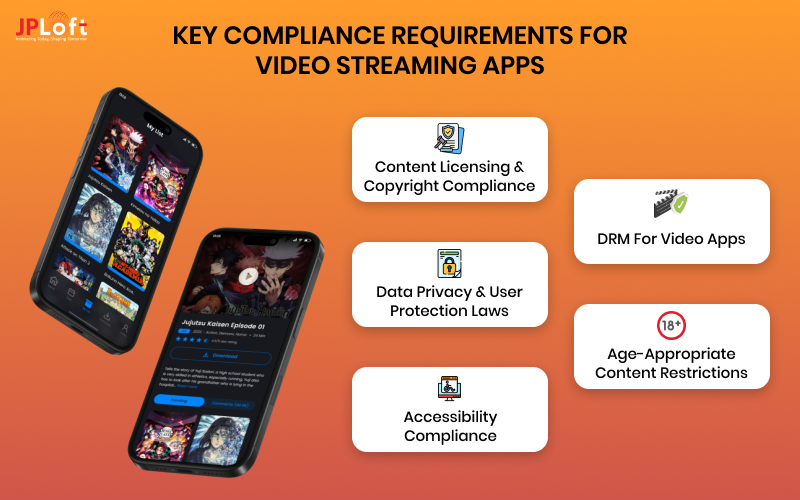
1] Content Licensing & Copyright Compliance
If you plan to stream licensed movies, shows, or music, you must secure proper distribution rights. Unauthorized use of copyrighted material can lead to severe penalties.
This applies to Video on Demand (VOD) app development and live broadcasts alike.
2] DRM for Video Apps
Implementing DRM for video apps (Digital Rights Management) is crucial for preventing piracy.
Technologies like Google Widevine, Apple FairPlay, or Microsoft PlayReady ensure only authorized users can access your premium content.
This is a must-have for secure video streaming solutions.
3] Data Privacy & User Protection Laws
A custom video streaming app must comply with global and regional data protection laws such as GDPR, CCPA, or local regulations.
This includes transparent privacy policies, user consent for data collection, and secure storage of personal information.
4] Age-Appropriate Content Restrictions
OTT platforms must classify and restrict content based on age ratings.
If you create a video streaming app with content for multiple demographics, you need parental controls and content filters.
5] Accessibility Compliance
To reach a wider audience, ensure your app meets accessibility guidelines, for example, adding closed captions, audio descriptions, and screen reader compatibility.
This is not only ethical but also improves user retention.
Bottom line: A legally compliant video streaming app not only avoids penalties but also builds user trust.
By integrating copyright protection, DRM for video apps, and strong privacy safeguards from day one, you create a secure, future-ready platform that can compete with the best video streaming apps worldwide.
How to Build a Video Streaming App?
The process of developing a video streaming app starts with intensive market research, selecting the right features, developing with top technologies, testing and then launching.
However, there’s a proven flow most projects follow to go from concept to a fully functional streaming platform.
The steps below will walk you through the typical video streaming app development guide, along with a few important considerations to ensure your project runs smoothly from start to finish.
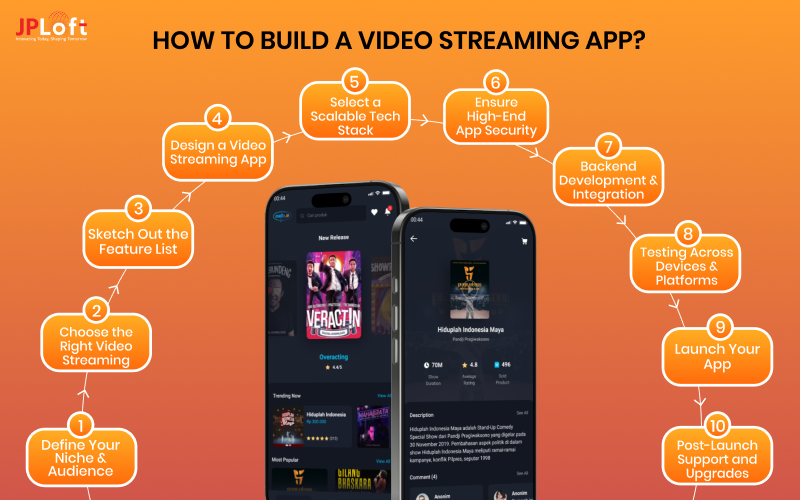
Step 1: Define Your Niche & Audience
Before diving into the technical side of the video streaming app development process, it’s crucial to clearly define your niche and target audience.
This sets the foundation for every decision that follows, whether it's design, functionality, content type, or monetization model.
Research Competitors: Study platforms like Netflix, Disney+ Hotstar, Twitch, or niche apps in your chosen category. See what’s working for them, where users complain, and where you can stand out.
This will also guide your feature priorities.
Select Platform & Delivery Model: Decide whether you’ll launch as a web-based platform, a mobile app (iOS, Android), or a cross-platform solution.
Also, determine if your content will be hosted on your own infrastructure or through cloud-based Content Delivery Networks (CDNs) for faster global streaming.
Popular monetization models include:
-
Subscription-based (SVOD): monthly/annual recurring fees (Netflix model)
-
Pay-per-view (TVOD): one-time payment for specific content
-
Ad-supported (AVOD): free viewing supported by ads
-
Hybrid: a mix of subscription and ads
Step 2: Choose the Right Video Streaming Model
Choosing the right video streaming model is a key decision that shapes your app’s structure, functionality, and user experience.
You can opt for a live streaming app model, similar to Twitch or Instagram Live, where content is broadcast in real-time to viewers.
Alternatively, you might go with a Video-on-Demand (VOD) model, like Netflix or Hulu, which allows users to watch pre-recorded content anytime.
For broader flexibility, many businesses prefer a hybrid model that combines both live streaming and VOD features to reach a wider audience.
The model you select will directly influence your user interface design, backend architecture, monetization model, and even the level of video streaming app security required to protect content and user data.
Step 3. Sketch Out the Feature List
Your app’s features are the backbone of the overall user experience, so it’s essential to plan them thoughtfully. Start with the basics like user registration and profile management to give users control over their accounts.
Functional and Non-Functional requirements you should know of
Functional requirements could include:
-
User registration/login
-
Content search & filtering
-
Playback controls
-
Multi-device sync
-
Offline downloads
Non-functional requirements focus on quality and performance, such as:
-
Low latency streaming
-
Adaptive bitrate for different internet speeds
-
Strong security for content protection
Step 4. Design a Video Streaming App That’s User-Centric
When you design a video streaming app, user experience must take center stage. A clean, intuitive, and visually engaging interface plays a key role in keeping users engaged and encouraging longer watch times. Even if your content is top-notch, a clunky design can quickly drive users away.
Information Architecture & Workflows: Map how users will navigate: from browsing categories to playing videos, creating playlists, or managing their subscriptions.
Wireframes: App wireframes show your app’s layout, including how thumbnails, search bars, and playback buttons will appear.
Style Guides: Define branding elements:
-
Color palette
-
Typography
-
Button styles
-
Thumbnail dimensions
Mockups & Prototypes: Turn wireframes into high-fidelity mockups, then into clickable app prototypes so you can test navigation and playback flow before development.
Step 5. Select a Scalable Tech Stack
App tech stack choices play a vital role in how to build a video streaming app as they directly influence the app’s performance, scalability, and user experience.
Pick your stack early:
-
Frontend: React Native, Flutter, or native iOS/Android
-
Backend: Node.js, Python, or Go with frameworks like Express or Django
-
Streaming Protocols: HLS, MPEG-DASH
-
Storage & Delivery: AWS S3, CloudFront, Akamai, or Vimeo OTT
Step 6. Ensure High-End Video Streaming App Security
App security isn’t optional, especially when dealing with licensed or user-generated content. To ensure your platform offers secure video streaming solutions, it’s essential to integrate multiple layers of protection.
Start with SSL encryption to secure data in transit and safeguard user privacy. Incorporate watermarking to trace unauthorized sharing and establish content ownership. Screen recording protection helps prevent digital piracy by restricting screen capture on both web and mobile platforms.
Most importantly, leverage DRM for video apps, such as Google Widevine or Apple FairPlay, to prevent content theft and ensure that your video assets are streamed only by authorized users.
Step 7. Backend Development & Integration
Now it’s time to develop a video streaming app by setting up your server-side infrastructure. This stage involves managing users and content effectively, handling video encoding and storage, and enabling real-time analytics to track user behavior and performance.
You'll also need to implement API integrations for features like payment gateways, push notifications, and user authentication.
Backend: Manages content storage, encoding, user accounts, payment processing, and analytics. Includes integrating a CDN for global content delivery.
Frontend: The interface users interact with — the home screen, content pages, player controls, and profile settings. Optimized for speed and responsive design.
Video Processing Pipeline: Handles video upload, transcoding into multiple resolutions, and adaptive streaming setup to ensure smooth playback on different devices and networks.
At this point, your development team will work on integrating the video player, organizing the media library, configuring the CDN for smooth content delivery, and connecting any essential third-party services required for seamless functionality.
Step 8. Testing Across Devices and Platforms
Before the big launch, it's essential to run thorough app testing to ensure your app performs flawlessly. Focus on checking playback speed and buffering times, evaluating the UI’s responsiveness, and making sure the payment flows work as expected.
Also, verify compatibility across different devices and platforms, including iOS, Android, and Smart TVs. Load testing should be performed to see how your app handles high traffic.
Test for:
-
Functionality: Play, pause, seek, resume, and playlist features.
-
Performance: Low buffering, quick load times, stable playback on high and low bandwidth.
-
Security: DRM integration (Widevine, FairPlay), SSL encryption, secure payment handling.
-
Device & Platform Compatibility: Mobile, tablet, smart TV, browsers.
Extended Review: Beta test with real users to gather feedback on video quality and navigation.
This comprehensive testing phase helps uncover bugs and ensures a smooth, secure, and seamless user experience before going public. It’s also a good idea to gather feedback from beta users to identify real-world issues early on.
Step 9. Launch Your App
Once you’re satisfied with the testing results, it’s time to make a video streaming app live across various platforms.
This stage is about making your app available to users. Publishing your app requires different processes for different platforms.
Publishing on the Apple App Store:
To launch on iOS, you’ll need an Apple Developer account. Upload your app build via Xcode or Transporter, fill out all required metadata (app name, description, screenshots, privacy policy), and submit it for review.
Apple’s review process is known for being strict, so ensure your app meets their design and technical guidelines.
Submitting to Google Play Store:
To submit app on Android, you’ll need a Google Play Developer account. Upload your APK or AAB file to the Google Play Console, provide store listing details, set pricing, and publish.
Google’s review process is generally quicker but still requires adherence to policies, especially regarding user data.
Web & Smart TV Platforms:
If your app is web-based or intended for OTT devices like Roku, Fire TV, or Apple TV, follow their specific submission guidelines.
Ensure your CDN is configured to handle global traffic and peak loads during launch campaigns.
Also, consider essential post-launch services like app store optimization, influencer outreach, email marketing, and issuing press releases to generate buzz and attract users.
Step 10. Post-Launch Support and Upgrades
After launching, your work isn’t over. It’s crucial to continuously monitor user behaviour, gather feedback, and push regular updates to fix bugs, improve overall performance, app maintenance service and add new features based on user demand.
Monitor KPIs like:
-
Average watch time
-
Monthly active users
-
Buffering ratio
-
Churn rate
-
Conversion rate from free to paid
Additionally, keep optimizing your server and storage costs to ensure long-term scalability and efficiency.
This ongoing process ensures that your custom video streaming app stays competitive, user-friendly, and future-ready in a fast-evolving digital landscape.
This commitment to continuous improvement not only enhances user satisfaction but also strengthens your app’s market position over time.
By following the steps to build a video streaming app outlined above, you’ll be well on your way to launching a powerful, engaging, and scalable video platform.
Tech Stack to Create a Video Streaming App
Choosing the right video streaming app tech stack is one of the most important decisions during the development process. It directly impacts your app’s performance, scalability, security, and ability to handle high traffic volumes without compromising user experience.
From seamless frontend interactions to powerful backend processing, every component plays a key role in delivering high-quality video content.
Here's a detailed breakdown of the recommended technologies that can help you build a robust and scalable video streaming application:
|
Component |
Recommended Technologies |
|
Frontend Development |
React Native, Flutter, Swift (iOS), Kotlin (Android) |
|
Backend Development |
Node.js, Ruby on Rails, Python (Django or Flask) |
|
Database |
MongoDB, PostgreSQL, MySQL |
|
Streaming Protocols |
HLS (HTTP Live Streaming), MPEG-DASH |
|
Cloud Hosting |
AWS, Google Cloud Platform, Microsoft Azure |
|
CDN (Content Delivery) |
Cloudflare, Akamai, Amazon CloudFront |
|
DRM for Video Apps |
Google Widevine, Apple FairPlay, Microsoft PlayReady |
|
Analytics |
Google Analytics, Mixpanel, Firebase |
|
Payment Gateways |
Stripe, PayPal, Razorpay |
|
Push Notifications |
Firebase Cloud Messaging, OneSignal |
This tech stack can be customized based on your app’s complexity, platform preferences, and feature requirements. Choosing the right tools ensures better performance, scalability, and user satisfaction.
How to Ensure Top-Notch Video Quality and Performance?
Even the most engaging content will fail if your streaming app can’t deliver smooth playback. Video quality and performance optimization ensure users enjoy a consistent, buffer-free experience regardless of their device or connection speed.
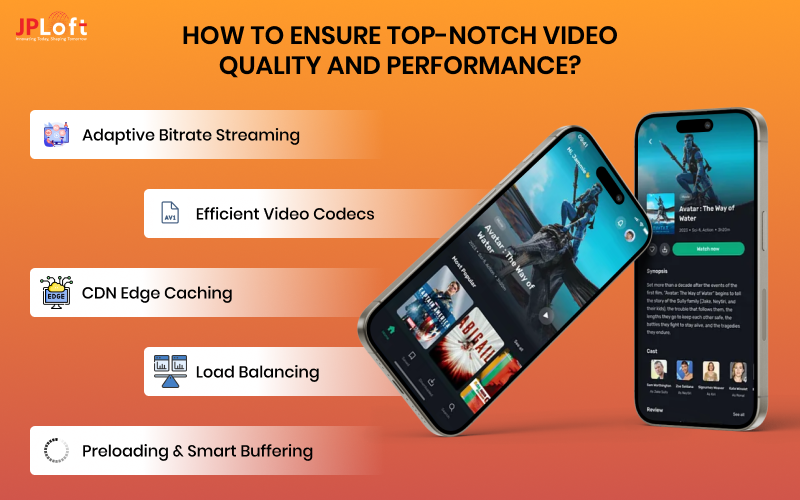
Key optimization strategies include:
-
Adaptive Bitrate Streaming (ABR): Adjusts video quality in real time based on the viewer’s internet speed, reducing buffering and interruptions.
-
Efficient Video Codecs: Use modern codecs like H.265 (HEVC) or AV1 for better compression without sacrificing quality.
-
CDN Edge Caching: Store and deliver content from servers closer to the user’s location to reduce latency.
-
Load Balancing: Distribute user traffic evenly across multiple servers to prevent overload during peak hours.
-
Preloading & Smart Buffering: Anticipate playback needs to ensure instant start and seamless viewing.
Optimizing both quality and performance doesn’t just improve user satisfaction — it also directly impacts retention, viewing time, and overall app ratings.
Cost to Develop a Video Streaming App
The cost to develop a video streaming app can range from $20,000 to $300,000+, depending on several factors like app complexity, UI/UX design, chosen tech stack, platform type (Android, iOS, or both), and the development team’s location.
A basic MVP might cost around $20K–$50K, while a full-featured app like Netflix or Shahid with adaptive streaming and advanced features can go well beyond $300K.
|
Feature/Stage |
Estimated Cost (USD) |
Short Description |
|
UI/UX Design |
$3,000 – $15,000 |
Wireframes, app prototyping, and front-end design |
|
Backend & Frontend Development |
$10,000 – $120,000 |
Core coding for app functionality and user interaction |
|
Streaming Protocol Integration |
$2,000 – $10,000 |
Integration of HLS, MPEG-DASH, or RTMP for video delivery |
|
Security Features (DRM, SSL, etc.) |
$3,000 – $20,000 |
Securing content using SSL, watermarking, and DRM |
|
Testing & QA |
$2,000 – $15,000 |
Bug fixing, compatibility, and performance testing |
|
Deployment & App Store Submission |
$1,000 – $5,000 |
To submit an iOS app to the App Store & publish to the Play Store |
|
Post-Launch Support & Maintenance |
$2,000 – $30,000+/year |
Updates, bug fixes, and performance optimization post-launch |
Collaborating with the best mobile app development company can ensure you stay on budget without compromising quality.
A well-planned budget and development roadmap can help reduce surprises. Investing wisely ensures your custom video streaming app performs well and scales as your audience grows.
Future Trends to Create a Video Streaming App
The video streaming industry is evolving rapidly, and staying ahead means embracing innovation and user-centric technology.
Here are the top future trends in video streaming apps:
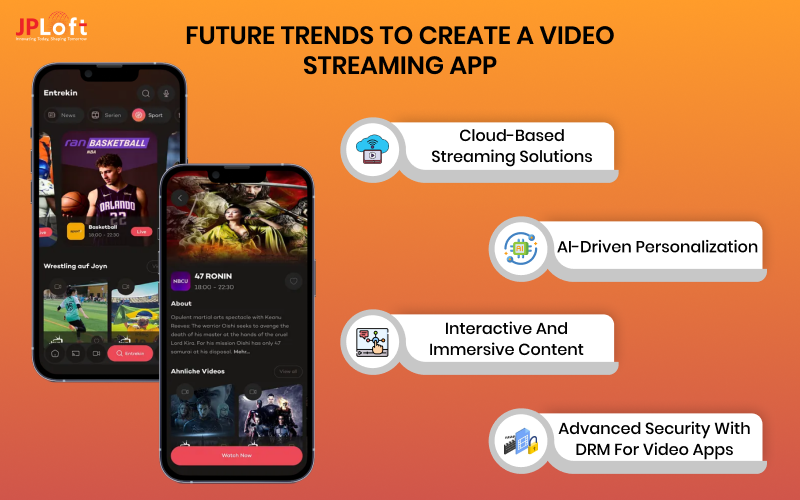
A] Cloud-Based Streaming Solutions
Cloud technology offers scalability and flexibility for custom video streaming apps. It enables faster content delivery, reduces latency, and supports global access without massive hardware investment.
By integrating cloud services, businesses can reach audiences across devices seamlessly.
B] AI-Driven Personalization
Artificial Intelligence is reshaping streaming by delivering tailored recommendations, dynamic thumbnails, and adaptive content experiences.
Using AI app development services allows seamless integration of these features, boosting user engagement, retention, and helping businesses build a video streaming app that stands out.
C] Interactive and Immersive Content
The rise of live streaming app development will see more interactive features such as polls, Q&A sessions, live reactions, and gamification.
Additionally, technologies like AR and VR will deliver immersive experiences, making it possible to stream concerts, events, and sports as if viewers were there in person.
D] Advanced Security with DRM for Video Apps
As piracy concerns grow, implementing secure video streaming solutions will be essential.
DRM for video apps will evolve with multi-layer encryption, watermarking, and AI-based piracy detection to ensure premium content is protected without affecting user experience.
By keeping these trends in mind, businesses looking to develop a video streaming app can future-proof their platforms, enhance user satisfaction, and remain competitive. The key lies in balancing cutting-edge technology with reliable performance and smooth scalability.
Mistakes to Avoid While Developing a Video Streaming App
When you set out to make a video streaming app, avoiding common pitfalls can save you time, money, and frustration.
Even small challenges of video streaming apps in planning or execution can lead to poor user experience, low adoption rates, or costly redesigns later. Let’s discuss it in short.
-
Ignoring scalability can cause performance issues and buffering during peak traffic.
-
Skipping DRM for video apps and other secure video streaming solutions leaves your content vulnerable to piracy.
-
Overloading the app with too many non-essential features instead of focusing on core features that users value most.
-
Neglecting proper testing across multiple devices, operating systems, and varying network conditions.
-
Selecting the wrong tech stack can lead to performance issues and difficulties in future scaling.
-
Failing to define a clear monetization model before starting development.
By carefully planning your features, prioritizing security, and choosing the right technology, you can build a reliable, engaging, and future-ready streaming platform.
Avoiding these mistakes is the first step toward long-term success in the competitive streaming market.
Monetization Models for Video Streaming Apps
When you develop a video streaming app, choosing the right video streaming app monetization is critical for ensuring profitability and sustainability.
Here are the most effective strategies to consider:
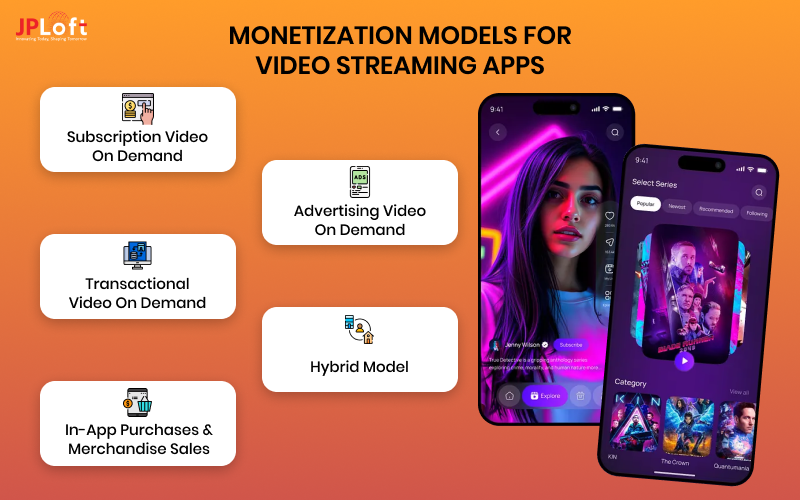
1. Subscription Video on Demand (SVOD)
This model allows users to pay a recurring fee (monthly, quarterly, or yearly) for unlimited access to content.
Popular examples include Netflix and Disney+. SVOD ensures predictable revenue and encourages long-term user retention.
2. Advertising Video on Demand (AVOD)
In AVOD, content is free for users, but ads are shown before, during, or after videos. Platforms like YouTube thrive on this model, making it ideal for attracting a wide audience while monetizing through advertisers.
3. Transactional Video on Demand (TVOD)
Also known as Pay-Per-View, users pay for each piece of content they watch. This model works well for premium or exclusive content such as sports events or movie releases.
4. Hybrid Model
Combining SVOD, AVOD, and TVOD allows you to cater to different audience segments. For example, you can offer a free ad-supported version alongside a premium ad-free subscription plan.
5. In-App Purchases & Merchandise Sales
Beyond streaming, you can integrate in-app purchases for exclusive features, digital goods, or even physical merchandise related to your content.
Selecting the right monetization strategy depends on your niche, target audience, and long-term business goals.
A well-planned model not only generates revenue but also enhances user satisfaction and loyalty.
How to Market Your Video Streaming App and Grow Audience?
Even the best-designed streaming platform needs the right strategy to attract and retain viewers. Knowing how to market a video streaming app is just as critical as building it.
Effective approaches to market a mobile video streaming app include:
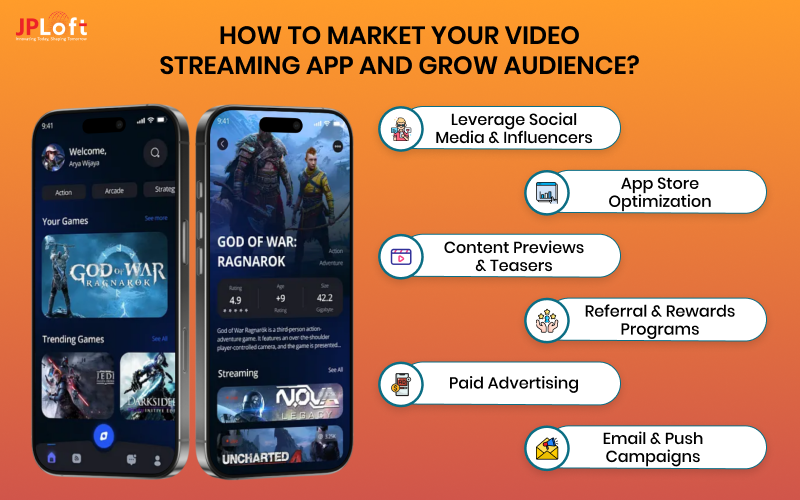
-
Leverage Social Media & Influencers: Partner with niche creators to promote your app to targeted audiences who are already engaged with streaming content.
-
App Store Optimization (ASO): Optimize your app title, description, and visuals to improve visibility and downloads in the App Store and Google Play.
-
Content Previews & Teasers: Release short clips or trailers on social platforms to generate curiosity before launch.
-
Referral & Rewards Programs: Encourage existing users to invite friends by offering free trials or exclusive content.
-
Paid Advertising: Run targeted ads on YouTube, Facebook, and Instagram to reach high-intent users.
-
Email & Push Campaigns: Keep your audience engaged with personalized content recommendations and updates.
If you are creating a video streaming app, one of the huge things to consider is how to market the app smoothly. After all, a strategic blend of organic and paid marketing not only boosts downloads but also ensures consistent viewer growth over time.
Why Choose JPLoft as Your Video Streaming App Development Partner?
Choosing the right video streaming app development company can make all the difference between a good app and a market-leading platform. At JPLoft, we combine technical expertise, innovative design, and deep industry knowledge to deliver streaming solutions that stand out.
Our team specializes in building scalable, feature-rich apps tailored to your unique business goals, whether you’re targeting movies, TV shows, live events, or niche content. From AI-driven personalization to high-quality video delivery, we ensure your platform is fast, secure, and user-friendly.
With end-to-end development support, transparent communication, and a proven track record, we empower you to launch a streaming app that attracts audiences and drives revenue.
Final Wrap-Up
If you're ready to create a video streaming app, the time to act is now. With rising demand for on-demand content and live interactions, video streaming platforms are rapidly becoming the future of digital entertainment.
From defining the app type to choosing the right features and tech stack, each step is crucial to delivering a seamless viewing experience. With technologies like DRM, predictive analytics, and live streaming infrastructure, your app can easily compete with the best in the business.
Whether you're a media startup or an established brand, launching a scalable, secure, and engaging video platform can open the doors to unlimited growth. So, go ahead and plan wisely, your audience is waiting.
FAQs
You can build live streaming apps, Video on Demand (VOD) apps, hybrid models, or even subscription-based streaming platforms.
The cost can vary from $20,000 to $300,000,+ depending on features, platforms, and integrations like DRM or live streaming.
Yes, through various models like SVOD (Subscription), AVOD (Ad-based), and TVOD (Pay-per-view).
Generally, it takes 3–6 months to develop a basic version and longer for advanced features or multi-platform apps.
To build a video streaming app, define your niche, choose a monetization model, select a tech stack, ensure DRM security, and launch across multiple platforms.





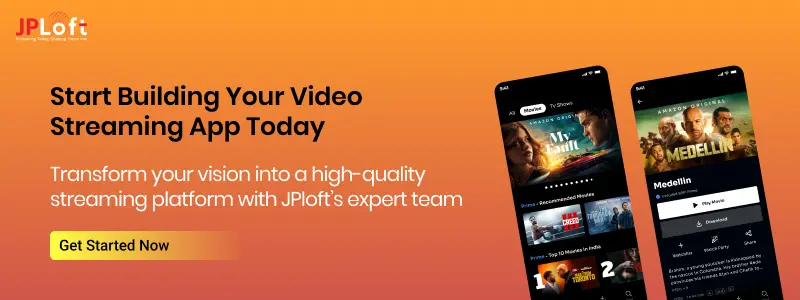
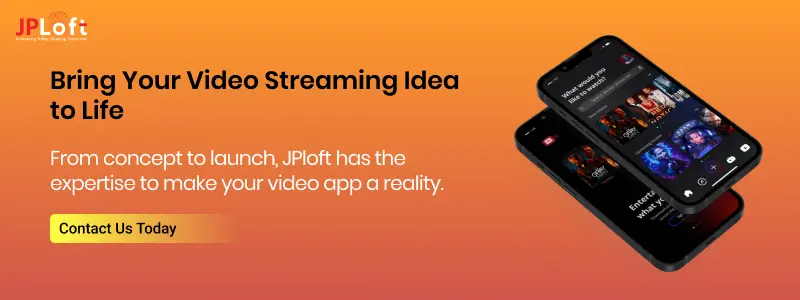


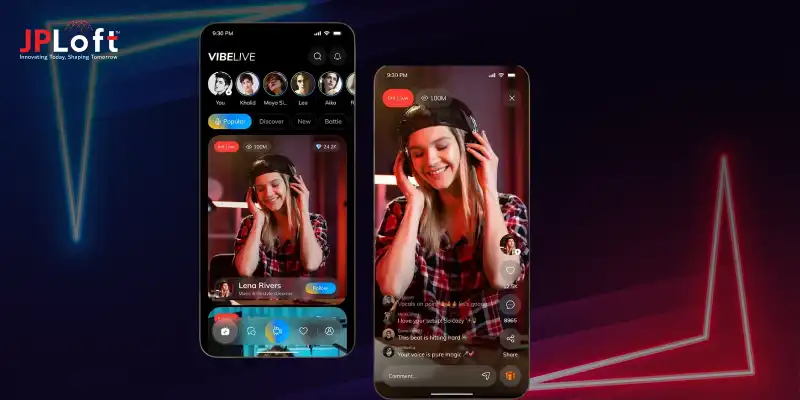
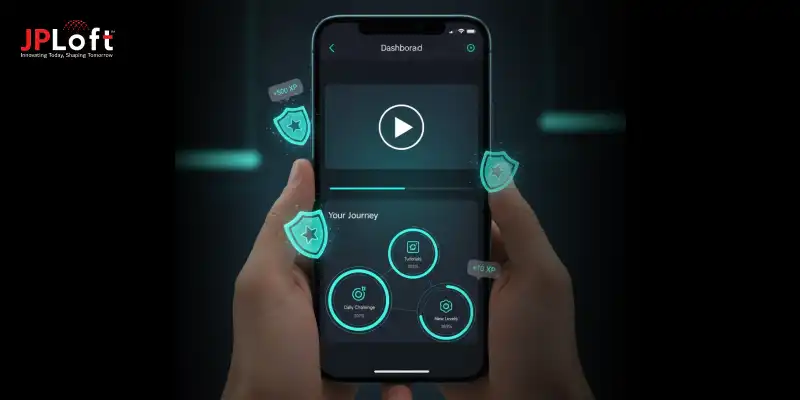
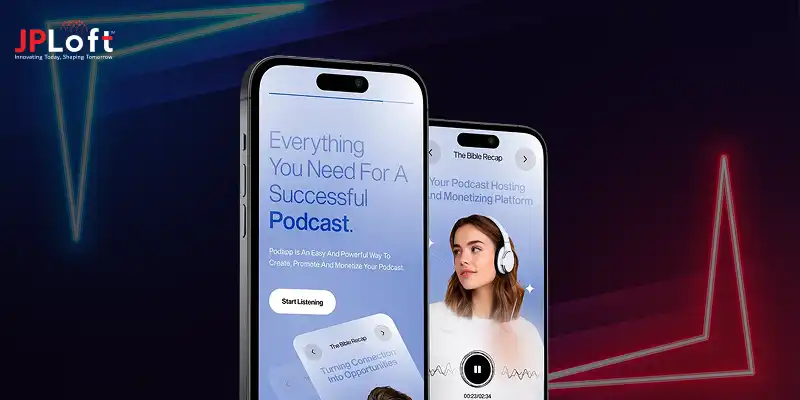


Share this blog